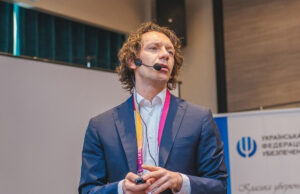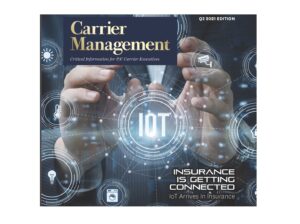When I was editing the last of a special set of articles in a section of Carrier Management’s third-quarter 2021 magazine, I struggled a bit with an opening sentence in one of the draft versions.
Guest editor Matteo Carbone, who co-authored every one of the five articles revealing how the promise of the Internet of Things has been realized by teams of connected device makers and insurers to promote safer driving, safer buildings and safer industrial conditions for workers, had written the following sentence:
“An important defining criteria for IoT is the physical and digital embodiment, and it is an enhancement of the ‘things’ capabilities thanks to the usage of the information.”
I grasped what he was trying to convey—the very definition of IoT, and the idea that embedded technology in networked physical objects produces valuable information, which prompts needed follow-up action based on what the objects are sensing and communicating. But I had a hunch that the sentence may have sounded more impactful in his native language of Italian. And I wanted the English sentence to have just as much force. Instead, it seemed like an awkward beginning.
I asked my sister, who has studied Italian, for help. “But I don’t know what the Internet of Things is about,” she protested. I summarized some of the information that Carbone and his co-authors from Church Mutual, Allstate, Nationwide, The Hartford and Strong Arm Technologies delivered in the articles, talking about sensors and wearables that create awareness of risks ranging from lead-footed drivers and flooded churches to speeding forklift operators and even armed intruders, as well as systems of incentives and rewards to promote less risky behaviors.
“Ah. In other words, ‘The IoT is the physical and digital realization of all that is possible—all that we thought was possible when we were imagining the future back when we were growing up in the 1960s,” my sister said.
Yes. That’s it! That’s exactly what he’s talking about. Well, pretty close anyway.
Ultimately, I chose not to open the article on page 38, “Using the IoT Paradigm to Prevent Worker Injury,” with either sentence. But I share the rewrite here because my sister, who isn’t even one of Carbone’s more than 177,000 LinkedIn followers, captured his enthusiasm and the essence of a message that he’s been delivering for more than a decade. As director of the IoT Insurance Observatory, he has been preaching about the value to insurers—in lowering loss ratios, staying engaged with policyholders, achieving returns on IoT investments—and the overarching benefit of creating a safer world. And he has been working with insurers and technology companies to demonstrate the possible use cases.
 Taking on the role of guest editor of Carrier Management, he and his co-authors deliver the latest news about IoT: Use cases are not only possible; they are reality.
Taking on the role of guest editor of Carrier Management, he and his co-authors deliver the latest news about IoT: Use cases are not only possible; they are reality.
Someone who does know Carbone well is Isabelle Flückiger, director of new technologies and data for The Geneva Association. She collaborated with Carbone for 10 months, researching and interviewing more than 100 players and thinkers in the IoT space to produce the Geneva Association report, “From Risk Transfer to Risk Prevention: How the Internet of Things is reshaping business models in insurance,” published in late May. In a recent article published on Medium.com and LinkedIn, Flückiger summarized 11 lessons she learned from a man with rock star status in the world of InsurTech. My personal favorite is No. 10: “It is passion, not a business, even though the business is perfectly organized.”
Explaining the lesson, Flückiger wrote, “The path to reach and stay at the top is stony and arduous. Only passion for your niche gives you the energy and perseverance to achieve success over all the many years…I asked him how he motivates himself again and again for nonstop learning and peak performance. And he told me, ‘I have one advantage over the others; it’s my topic, it’s my passion, and I devote my life to that.'”
The lesson: “You must go all-in with devotion and passion. The difference between being good and being great is the fervor for a theme,” she wrote.
The articles in the “Insurance Is Getting Connected” feature that spans 20 pages of the third-quarter edition of Carrier Management’s magazine (listed in the textbox to the right) are based upon the extensive research and interviews Carbone and Flückiger did together to bring to life his niche, his passion—IoT applications in insurance. For Carrier Management, Carbone volunteered for the task of reuniting with five of the interview subjects again to delve more deeply into the ingredients for IoT success and their realization of sustainable business cases around risk prevention that exemplify two approaches specifically highlighted in the report: real-time risk mitigation and the promotion of less risky behaviors.
The stories center around the protection of individuals and businesses, told from the vantage points of the industry’s strongest advocate of IoT solutions and insurers of commercial property, private passenger autos, commercial fleets, the construction sector and a technology company devoted to the safety of “industrial athletes” (a trademarked term for co-author StrongArm Technologies).
“I pushed each company for concrete actionable insights to differentiate this from common marketing statements circulated by their PR,” Carbone wrote to me in a recent email, describing his intent.
Carrier Management is pleased to present this collection of articles delivering heroically on the goal Carbone set out for himself and his co-creators.
More About Matteo Carbone
Matteo Carbone is Director of the IoT Insurance Observatory and a board member of Net Insurance. In addition to founding the Observatory, Carbone is the author of a book titled “All the Insurance Players Will Be InsurTech” and guest editor of this special report on IoT insurance applications for Carrier Management.
A frequent contributor, Carbone was also a guest editor for CM’s 2018 featured magazine section, “Startups Face Off Against Established Players,” a series of articles about innovation in insurance (November/December 2018 edition; co-editor Adrian Jones).
When Carbone did his last stint as guest editor, he was also actively involved in publishing articles about VC-backed InsurTech carriersLemonade, Root and Metromile, shining the light on the little-appreciated insurance KPIs of the three well before post-IPO scrutiny of their financial results became more fashionable. An avid supporter of InsurTech, Carbone still felt compelled to “comment in a different way than 90 percent of the people that go to the conferences and publish articles about InsurTech,” he told CM at the time. He wasn’t comfortable with “cheerleaders for innovation,” who applaud new ideas simply because they are new or different.
“I have been talking about innovation for a few years, and before it was called InsurTech. And I started from an insurance angle…And I have built my voice in the market on a specific idea, which is that I strongly believe that technology is not good per se. It is good if it is bringing some concrete value—meaning profitability, something that can improve the profitability of an insurance company, something that can allow them to sell more, to generate more product, or something that can allow them to be closer to customers (proximity), or something that can reduce the lapse (persistency).”
In short, the technology needs to “generate tangible economic value,” said Carbone.
A self-described “non-conformist,” Carbone recently said on LinkedIn that the hashtag #digitalnomadlife is the label that best describes his life. Digital nomads are described in a recent Harvard Business Review article as “people who embrace a location-independent, technology-enabled lifestyle that allows them to travel and work anywhere in the Internet-connected world.” Providing evidence of the appropriateness of the hashtag, Carbone’s LinkedIn post documented 20 stops he made during the last 16 months of his journey around the globe, pursuing his dual missions of advising insurers on innovation and arming them with data he’s accumulated about insurance IoT.
“It does not matter in which time zone Matteo is. When the audience needs him, he devotes his time even in the middle of the night. When the customer requires new insights, he delivers on time,” wrote Isabelle Flückiger of the Geneva Association in a summary of the lessons she learned collaborating with him on the report, “From Risk Transfer to Risk Prevention: How the Internet of Things is reshaping business models in insurance.” Flückiger, in her own analysis of Carbone’s globetrotting, wrote that “customer centricity is a lifestyle.”
Connecting with his customers, and encouraging insurers to connect with theirs, Carbone is pushing insurers to realize his vision of the future of insurance—one in which they connect to policyholders’ lives and engage with them in risk prevention.






















 Heating Fuel Haulers Temporarily Exempt From Drive Time Limits
Heating Fuel Haulers Temporarily Exempt From Drive Time Limits  Howden US Tells Judge Brown & Brown Employees Fled Due to ‘Mistreatment’
Howden US Tells Judge Brown & Brown Employees Fled Due to ‘Mistreatment’  Good Times for U.S. P/C Insurers May Not Last; Auto Challenges Ahead
Good Times for U.S. P/C Insurers May Not Last; Auto Challenges Ahead  Underwriter, Actuary Fears of AI Drop; Work Needed on Collaboration
Underwriter, Actuary Fears of AI Drop; Work Needed on Collaboration 











